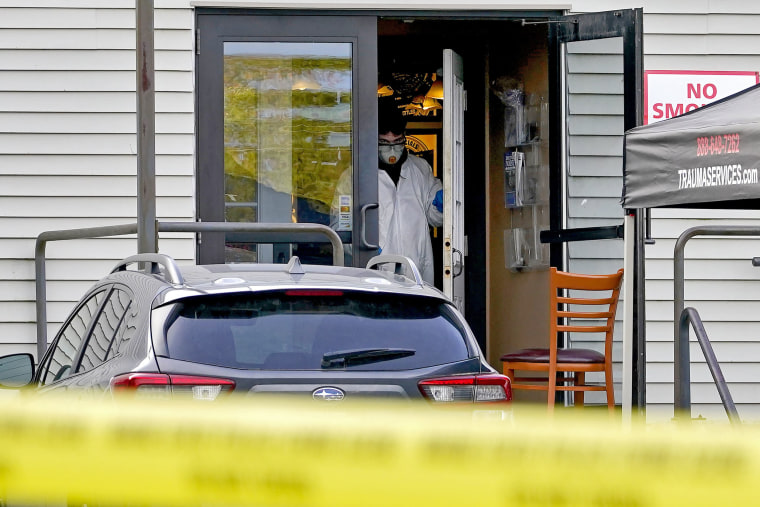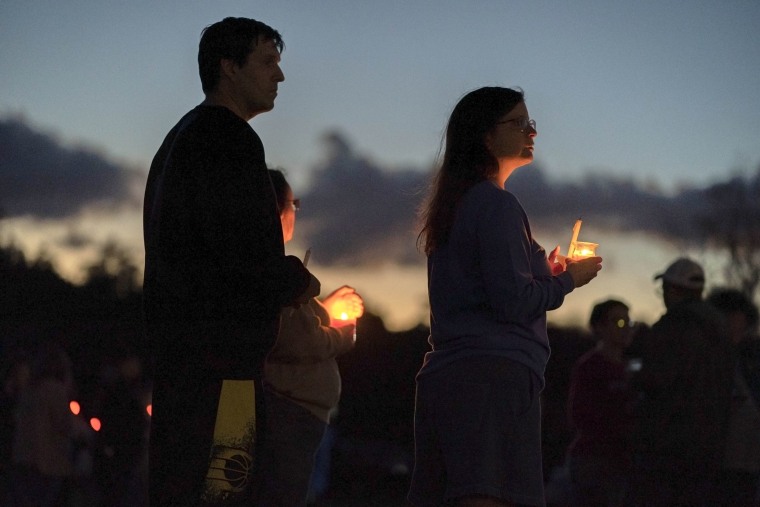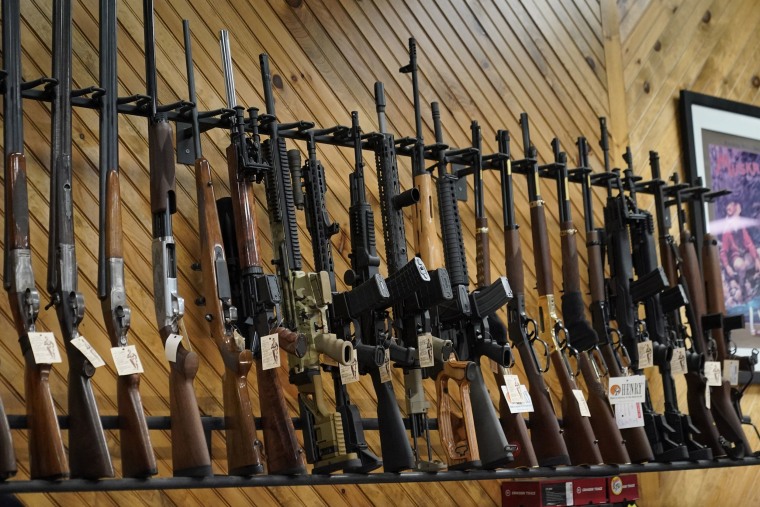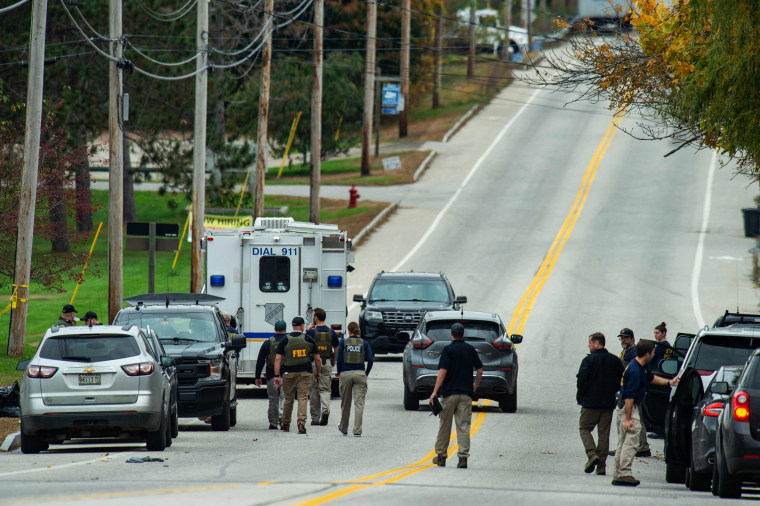Maine’s yellow flag law is supposed to prompt authorities to restrict gun access for potentially dangerous people. But weaknesses in the 3-year-old law led to at least one shooting years before a gunman killed 18 people in Lewiston last month, sparking a national debate around the effectiveness of laws that are supposed to prevent such massacres.
In February 2021, Shaun Simmons’ family grew increasingly concerned over remarks he made about killing himself and a man his mother was dating, according to his brother-in-law, Brian Dunnigan.
Simmons, 57, who suffered from severe alcoholism, had purchased a Sig Sauer 9 mm pistol while intoxicated, which escalated fears that he would carry out his threats, Dunnigan said.
Dunnigan, a paramedic at the time who had seen hundreds of firearm-related incidents over nearly three decades on the job, said he called his local police department to trigger Maine’s yellow flag law. The measure, unique to the state, allows law enforcement to begin a multistep process to restrict a dangerous person’s access to guns.
“I begged the police,” Dunnigan said.
But the Wells Police Department did not attempt to evaluate Simmons. Police Chief Jo-Ann Putnam told NBC News that the agency did not conduct a welfare check because the family had not requested one, because Simmons lived with his mother and not alone, and because it was not clear from Dunnigan’s call that Simmons posed an imminent threat — all of which Dunnigan disputes.
Less than three weeks after Dunnigan went to police, Simmons shot his mother’s boyfriend in the chest in front of her, then sat on the couch and killed himself.
“The gun was on the floor right in front of his feet,” Dunnigan said, “the same gun that I had tried to get away from him.”
‘Two steps too many’
The double shooting in Wells happened less than 70 miles from Lewiston, where a U.S. Army reservist fatally shot 18 people on Oct. 25, despite his family warning law enforcement and military officials about his deteriorating mental health.

Both tragedies have become stark examples of the complexities of the law — and what critics call its failures — after it was enacted in 2019 in direct response to the Parkland, Florida, high school shooting and other massacres like it.
“Our yellow flag law, which is the only state that has one, makes us an outlier, not a model,” said Margaret Groban, a former federal prosecutor who teaches firearms regulation at the University of Maine School of Law.
The law, gun safety advocates said, is a watered-down version of the so-called red flag laws that have been adopted by 21 states. These laws vary but generally require fewer procedural steps.
Under Maine’s law, a person who is concerned that a family member may be a threat to themself or others must first alert law enforcement, which would then take the family member into protective custody, according to Nick Suplina, senior vice president for law and policy at Everytown for Gun Safety, a national gun violence prevention nonprofit.
From there, a medical professional would need to evaluate the family member and deem them a threat — an added barrier that is not required under red flag laws, experts said. Only after a medical diagnosis could a judge approve an order to temporarily remove the firearm.
That is “two steps too many,” Groban said.
Police officials in Maine have repeatedly declined to say whether law enforcement failed to act under the state’s yellow flag law to prevent the Lewiston mass shooting. The gunman in that case had been hearing voices for months, according to his family, who said they had reached out to police and the Army Reserve as they “got increasingly concerned.”
In July, when the shooter’s unit was undergoing annual training in New York, Army leaders took him to receive psychiatric treatment and later directed that he not have weapons, Army spokesperson Bryce Dubee said.
Military officials made multiple attempts to contact him in the months that followed and requested local police conduct a welfare check, Dubee said. The Sagadahoc County Sheriff’s Office has said that it conducted the check but that no one answered the door.
At a news conference a week ago, Michael Sauschuck, commissioner of the Maine Department of Public Safety, said, “I’m not gonna talk about who knew what and when.”
The agency on Friday directed comment to the Sagadahoc County Sheriff’s Office, which did not immediately respond.
Lewiston deepens old wounds
In Wells, the latest shooting has inflamed unhealed wounds for Simmons’ family.
“All of this news just brings up more feelings of guilt and pain, and it’s hard,” Simmons’ sister, Sharon Simmons-Dunnigan, said through tears. “We just try to suppress everything just to go on every day.”

Dunnigan said he thinks about what happened “all the time” and remembers vivid details of the shooting and his communications with the Wells Police Department weeks before the tragedy.
While Putnam, the police chief, said Dunnigan’s call was “informational in nature” and insists Dunnigan did not indicate that his brother-in-law was an imminent threat, Dunnigan strongly disagrees.
He said he clearly laid out the factors that made him believe Simmons was a danger and insisted officers take actions toward removing his firearm. But, he said, “they didn’t attempt to do anything.”
Putnam did not share the officer’s notes and said there is no audio recording of the call that could prove either side.
Text only says ‘Shaun shooting’
On March 14, 2021, Simmons-Dunnigan received a startling text message from her mother with only two words: “Shaun shooting.”
“She turned 10 sheets of white,” her husband said. Dunnigan said he knew exactly what had unfolded before rushing to his mother-in-law’s house less than two miles away and seeing the aftermath of the violence with his own eyes.
The man Simmons shot was rushed to the hospital in critical condition and survived.
Dunnigan believes that if police had checked on Simmons, it “would have given him complete pause” and changed his mind. In Dunnigan’s fury, he has tried to seek accountability for his brother-in-law’s death, including requesting that the state’s attorney general investigate how the Wells Police Department handled his call.
The attorney general’s office said it “retains no operational control over local law enforcement agencies.”
“I wish they could have done more,” Simmons’ sister said. “I just can’t focus on that part, for me, to heal.”
Putnam said the incident is a “clear example” of how complex Maine’s yellow flag law is and that it does not provide a “one size fits all” guide to what law enforcement officers legally can or cannot do.
“While it can be used successfully, it does not always apply or work in all cases,” the police chief said.

The yellow flag law has been used 82 times since it went into effect in July 2020, according to data released by state officials last week. The vast majority of incidents involve people warning law enforcement that a loved one, in possession of a firearm, is threatening suicide.
The Wells Police Department has used it effectively three times. In the latest instance in April, the husband of a 43-year-old intoxicated woman, who had a history of making suicidal threats when drunk, reported that she had a loaded handgun and threatened to make a TikTok video of her killing herself, officials said.
Republican State Sen. Lisa Keim, who sponsored the law, defended it as a useful tool that protects a person’s constitutional rights by equipping judges with credible information rather than forcing them to make blind decisions.
But Keim said it has taken some time for the law to gain its footing. In 2021, when the double shooting occurred, the measure had not yet been “implemented as robustly as it should” have because the state did not have enough mental health providers to do assessments, Keim said, adding that law enforcement also had to catch up with training.
Maine only recently nailed down a system to handle the law’s mental health requirement by signing a contract with a company that can conduct assessments remotely, Keim said.
“That really has been game-changing,” she said. “I can only imagine that it’s going to be used with increasing frequency now.”
For Simmons, who was remembered for his intelligence, generosity and passion for cooking, such progress is too late, his family said.
“It was such a waste of a life,” Dunnigan said. “His blood is on their hands.”

